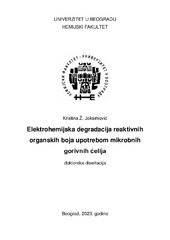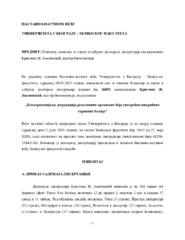Приказ основних података о документу
Elektrohemijska degradacija reaktivnih organskih boja upotrebom mikrobnih gorivnih ćelija
| dc.contributor | Manojlović, Dragan | |
| dc.contributor | Gojgić-Cvijović, Gordana | |
| dc.contributor | Vujisić, Ljubodrag | |
| dc.contributor.advisor | Beškoski, Vladimir | |
| dc.contributor.advisor | Randjelović, Danijela | |
| dc.creator | Joksimović, Kristina | |
| dc.date.accessioned | 2023-11-28T10:41:43Z | |
| dc.date.available | 2023-11-28T10:41:43Z | |
| dc.date.issued | 2023 | |
| dc.identifier.uri | https://cer.ihtm.bg.ac.rs/handle/123456789/6908 | |
| dc.description.abstract | Cilj ove disertacije je primena MFC sistema kao obnovljivog izvora „zelene“ energije za tretman otpadnih voda. U tu svrhu je izvršena optimizacija MFC radi dobijanja struje odgovarajućeg intenziteta, koja se može iskoristiti za razgradnju reaktivnih organskih boja, glavnih zagađujućih supstanci otpadnih voda. Prvi deo istraživanja obuhvata fizičko-hemijsku i mikrobiološku karakterizaciju rečnog sedimenta koji je dalje korišćen za konstrukciju MFC sistema. Formirane su četiri MFC ćelije: sa sterilnim, sa originalnim, sa biostimulisanim i sa biostimulisanim/biaugmentisanim rečnim sedimentom. Merenja napona na formiranim ćelijama su pokazala da MFC sistem sa biostimulisanim sedimentom daje najbolje performanse. Fokus u drugom delu eksperimenata je bio izolovanje i karakterizacija mikroorganizama koji su dominantno zastupljeni u sedimentu, a ujedno su i zaslužni za procese oksidacije u anodnom delu koji omogućavaju generisanje struje preko MFC. Izvršena je metagenomska analiza u uzorku rečnog sedimenta i u biostimulisanom rečnom sedimentu, kako bi se uporedio profil zastupljenih zajednica mikroorganizama. Studija degradacije i dekolorizacije Reactive Black 5 (RB5) azo boje izvedena je pomoću elektrohemijski unapređenog oksidacionog procesa i opisana je u trećem segmentu disertacije. Elektro-Fentonov proces je uspostavljen upotrebom radne elektrode od 15% Fe i dodatkom H2O2 u rastvor RB5 boje, dok je set od tri paralelno vezane MFC, sa biostimulisanim sedimentom, služio kao izvor struje. Optimizacija procesa elektrohemijskog tretmana RB5 je sprovedena na koncentraciji boje od 25 mg/L. Efikasnost degradacija RB5 boje je potvrđena upotrebom analitičkih metoda UV/VIS, FTIR i HPLC-MS. Testovi za procenu ekotoksičnosti, izvedeni pomoću Aliivibrio fischeri, pokazuju da su degradacioni proizvodi nastali u ovom eksperimentu manje toksični od polazne boje. | sr |
| dc.description.abstract | The goal of this dissertation is application of the MFC system as a renewable „green“ energy source in wasterwater treatment. For this purpose MFC was optimized in order to obtain a suitable amount of electricity that can be used to decompose reactive organic dyes, the primary pollutants of wastewaters.The first part of the research includes physico-chemical and microbiological analysis of the river sediment, which was further used to construct the MFC system. Four MFC cells were formed containing: sterile, original, stimulated and biostimulated/bioaugmented river sediment. Voltage measurements on the established cells showed that the MFC with biostimulated sediment exibited the best performance. The focus of the second part of the study was the isolation and characterization of microorganisms that are dominantly represented in the sediment, which enable the generation of current through the MFC. Metagenomic analysis was used to compare the profiles of microbial populations in a composite of river sediment and biostimulated river sediment. The study of degradation and decolorization of Reactive Black 5 (RB5) azo dye investigated using an electrochemically improved oxidation process is described in the last part of the dissertation. The Electro-Fenton process was established using a working electrode of 15% Fe and the addition of H2O2 to the RB5 dye solution, while a set of three MFCs connected in parallel, with biostimulated sediment, served as the current source. Optimization of the RB5 electrochemical treatment process was carried out at a dye concentration of 25 mg/L. The efficiency of degradation of RB5 dye was confirmed using analytical methods UV/VIS, FTIR and HPLC-MS. Ecotoxicity assessment tests, performed using Aliivibrio fischeri, show that the degradation products formed in this experiment are less toxic than the starting dye. | sr |
| dc.language.iso | sr | sr |
| dc.publisher | Универзитет у Београду - Хемијски факултет | sr |
| dc.relation | info:eu-repo/grantAgreement/MESTD/inst-2020/200026/RS// | sr |
| dc.relation | info:eu-repo/grantAgreement/MESTD/inst-2020/200168/RS// | sr |
| dc.rights | openAccess | sr |
| dc.rights.uri | https://creativecommons.org/licenses/by/4.0/ | |
| dc.subject | mikrobne gorivne ćelije | sr |
| dc.subject | metagenomska analiza | sr |
| dc.subject | degradacija Reactive Black 5 | sr |
| dc.subject | elektro-Fentonov proces | sr |
| dc.subject | microbial fuel cell | sr |
| dc.subject | metagenomics analysis | sr |
| dc.subject | degradation of Reactive Black 5 | sr |
| dc.subject | electro-Fenton process | sr |
| dc.title | Elektrohemijska degradacija reaktivnih organskih boja upotrebom mikrobnih gorivnih ćelija | sr |
| dc.type | doctoralThesis | sr |
| dc.rights.license | BY | sr |
| dc.identifier.rcub | https://hdl.handle.net/21.15107/rcub_cer_6908 | |
| dc.identifier.fulltext | http://cer.ihtm.bg.ac.rs/bitstream/id/28135/bitstream_28135.pdf | |
| dc.identifier.fulltext | http://cer.ihtm.bg.ac.rs/bitstream/id/28138/bitstream_28138.pdf | |
| dc.type.version | publishedVersion | sr |



